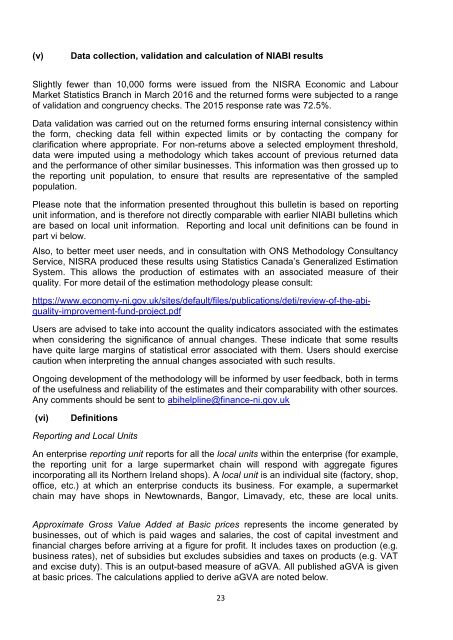ABI-2015
ABI-2015
ABI-2015
Create successful ePaper yourself
Turn your PDF publications into a flip-book with our unique Google optimized e-Paper software.
(v)<br />
Data collection, validation and calculation of NI<strong>ABI</strong> results<br />
Slightly fewer than 10,000 forms were issued from the NISRA Economic and Labour<br />
Market Statistics Branch in March 2016 and the returned forms were subjected to a range<br />
of validation and congruency checks. The <strong>2015</strong> response rate was 72.5%.<br />
Data validation was carried out on the returned forms ensuring internal consistency within<br />
the form, checking data fell within expected limits or by contacting the company for<br />
clarification where appropriate. For non-returns above a selected employment threshold,<br />
data were imputed using a methodology which takes account of previous returned data<br />
and the performance of other similar businesses. This information was then grossed up to<br />
the reporting unit population, to ensure that results are representative of the sampled<br />
population.<br />
Please note that the information presented throughout this bulletin is based on reporting<br />
unit information, and is therefore not directly comparable with earlier NI<strong>ABI</strong> bulletins which<br />
are based on local unit information. Reporting and local unit definitions can be found in<br />
part vi below.<br />
Also, to better meet user needs, and in consultation with ONS Methodology Consultancy<br />
Service, NISRA produced these results using Statistics Canada’s Generalized Estimation<br />
System. This allows the production of estimates with an associated measure of their<br />
quality. For more detail of the estimation methodology please consult:<br />
https://www.economy-ni.gov.uk/sites/default/files/publications/deti/review-of-the-abiquality-improvement-fund-project.pdf<br />
Users are advised to take into account the quality indicators associated with the estimates<br />
when considering the significance of annual changes. These indicate that some results<br />
have quite large margins of statistical error associated with them. Users should exercise<br />
caution when interpreting the annual changes associated with such results.<br />
Ongoing development of the methodology will be informed by user feedback, both in terms<br />
of the usefulness and reliability of the estimates and their comparability with other sources.<br />
Any comments should be sent to abihelpline@finance-ni.gov.uk<br />
(vi)<br />
Definitions<br />
Reporting and Local Units<br />
An enterprise reporting unit reports for all the local units within the enterprise (for example,<br />
the reporting unit for a large supermarket chain will respond with aggregate figures<br />
incorporating all its Northern Ireland shops). A local unit is an individual site (factory, shop,<br />
office, etc.) at which an enterprise conducts its business. For example, a supermarket<br />
chain may have shops in Newtownards, Bangor, Limavady, etc, these are local units.<br />
Approximate Gross Value Added at Basic prices represents the income generated by<br />
businesses, out of which is paid wages and salaries, the cost of capital investment and<br />
financial charges before arriving at a figure for profit. It includes taxes on production (e.g.<br />
business rates), net of subsidies but excludes subsidies and taxes on products (e.g. VAT<br />
and excise duty). This is an output-based measure of aGVA. All published aGVA is given<br />
at basic prices. The calculations applied to derive aGVA are noted below.<br />
23



